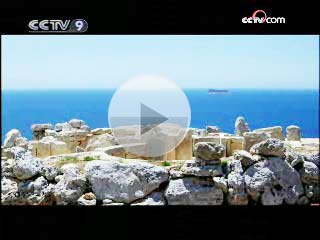Source: CCTV.com
11-28-2008 09:38
 |
There is a huge contrast between the eternity of stone and the transience of life. Human beings, recognizing and honouring the resilience of stone have, since ancient times, fashioned works of art from it.
3,600 kilometres off the coast of Chile lies an island, floating in the sea like an abandoned boat. This is Easter Island, where at sunset every day, a series of sculptures impose their distinctive outlines on the grassland. These are the so-called moai, for which Easter Island is famous. Rising between 5 and 10 meters, each weighs dozens of tons. Most surprising are the giant stone hats some of them wear, weighing as much as 20 tons.
-da.jpg) |
A statue of Athena, goddess of wisdom and protector of Athens in Greek mythology, used to dominate the main hall at the Parthenon. 13 metres high, the statue was made of silver-white marble. Sadly, it was destroyed at the time of the Byzantine Empire. The Athena now on display at the Parthenon is a duplicate in miniature. The goddess is dressed in a helmet and one-piece dress. Her breastplate and weapons are decorated with human figures and have zigzagging edges. Her figure is redolent of maternal gentleness and steadfastness.
In China, there are stone carvings as huge as the 71-metre Leshan Giant Buddha, and others as small as handicrafts for people to carry with them. The handicrafts are popular among collectors because they can be appreciated close-up. Because of this, they would appear to have much greater artistic value.
Close-up: Cangtianyuan, Fujian Province, China
The stone carvings, which vary in their style and appearance, have an appealing translucent quality. Admirers find it hard to resist picking them up to examine them. Such close examination reveals something remarkable; the stone of which they are all made comes from the same origin. That place is Shoushan in Fujian Province.
Stone deposits are concentrated near the mountains and streams that surround Shoushan Village, in the northern suburbs of Fuzhou. They extend from Qishan in the west as far as the border with Lianjiang County in the east, and from Dunyang in the north to Yueyang in the south. They occupy a region that is notable for its pleasant landscapes and agreeable climate.
During the Jurassic Period, over 150 million years ago, a violent volcanic eruption devastated this region. Lava poured down the mountains and was turned into volcanic rock. However, this lava was special – it was rich in acid gas. It mixed with the underground water and minerals. Together they formed a hot liquid that oozed out through the cracks between the rocks. This boiling liquid was deposited on the nearby rocks, where it crystallized and finally formed natural mineral veins.
In the course of the next tens of thousands of years, the rains and floods carried these rocks to the riverbanks and fields. There, with time, they were submerged into the soil, where they were turned into precious stones. These are what we know today as Shoushan Stones.
Shoushan Stones, in terms of their moisture content, are the rival of jade. But unlike jade, they embody a unique spectrum of rich natural colours.
So, following their prolonged birth, how were these precious stones first discovered?
During the Northern and Southern Dynasties, in the 5th and 6th centuries, some monks from a temple in the remote mountains of Fujian, chanced upon the stones. The monks decide to make gifts out of the stones in honour of the Buddha, which they would give away to pilgrims. So the stones were fashioned into prayer beads and Buddhist statues. With time, more and more pilgrims began coming, hoping to be given one of these precious gifts.
The Shoushan Stone Pig dates from the Southern Dynasties, some 1,500 years ago. It was produced as a burial object. Its simple lines and carving reveal how basic were stone-working techniques at the time. Even so, such works marked the beginning of the tradition of Shoushan Stone Carving.
Shoushan Stones, depending on where they come from, fall into three categories. Shankeng Stones come from mountains, Shuikeng Stones from water, and Tiankeng Stones form paddy fields. The most precious of the Shoushan Stones are Tianhuang Stones, which belong to the category of Tiankeng Stones.
The story goes that the Qing Emperor Qianlong, who reigned in the 18th century, had a dream in which he was summoned by the Jade Emperor, who gave him a yellow stone. When he awoke, the emperor decided that the dream had been propitious. But he could not work out its exact meaning.
